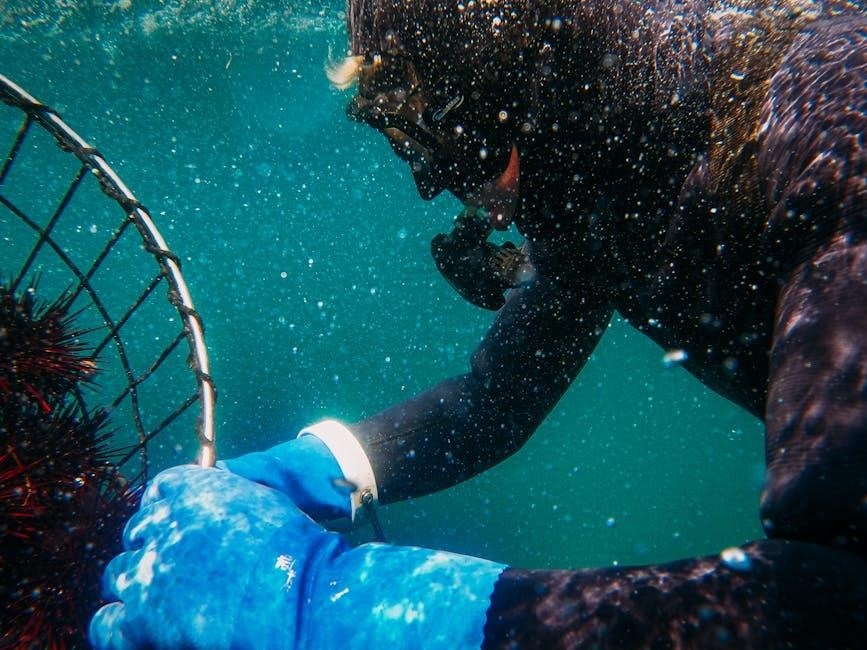U.S. Navy Diving Manual: An Overview
The U.S. Navy Diving Manual serves as a cornerstone resource for diver training and operational procedures. Since its initial publication in 1905, it has evolved through numerous revisions, reflecting advancements in diving technology, physiology, and safety protocols. It represents the official standards and guidelines for the US Navy.
Purpose and Scope
The primary purpose of the U.S. Navy Diving Manual is to provide a comprehensive, standardized resource for all aspects of diving operations within the Navy. It serves as the definitive guide for diver training, equipment usage, operational planning, and emergency procedures. The manual aims to ensure the safety and effectiveness of Navy divers in a wide range of underwater environments and tasks. Its scope encompasses various diving modes, including air diving, mixed-gas diving, and surface-supplied diving, addressing the specific challenges and considerations associated with each.
Furthermore, the manual details medical aspects of diving, including the recognition and treatment of diving-related injuries and illnesses. It also provides guidance on decompression procedures, chamber operations, and hyperbaric medicine. The manual is intended for use by all personnel involved in diving operations, from novice divers to experienced supervisors and medical officers. Finally, the U.S. Navy Diving Manual has become a reference for the diving community internationally.
Historical Context: From 1905 to Present
The U.S. Navy’s commitment to diving safety and operational effectiveness is reflected in the long history of its diving manual. The journey began in 1905 with the initial provision of diving guidance, marking the formal recognition of the need for standardized procedures. This early manual laid the groundwork for future editions, evolving alongside advancements in diving technology and medical understanding.
A significant milestone arrived in 1916 with the publication of the first book formally titled “Diving Manual,” attributed to Gunner Stillson. This manual represented a substantial improvement, solidifying its place as a foundational document. Subsequent revisions were published periodically, each building upon previous knowledge and incorporating lessons learned from operational experience. These included updates from the Bureau of Construction and Repair, and later the Bureau of Ships.
The manual’s evolution continues to the present day, reflecting ongoing research and development in diving techniques, equipment, and safety protocols.

Key Revisions and Editions
Over the years, the U.S. Navy Diving Manual has undergone several key revisions and editions, each reflecting the latest advancements in diving technology, procedures, and safety protocols. These revisions mark significant milestones in the manual’s evolution.
Diving Manual (1916)
The 1916 Diving Manual stands as a pivotal moment in the history of U.S. Navy diving. It succeeded the initial 1905 manual, marking the first instance the book was officially titled “Diving Manual.” This edition, notably improved by Gunner Stillson, represented a significant leap forward in providing comprehensive guidance for diving operations.
It served as the foundational text for training and procedures, standardizing practices across the Navy’s diving programs. The manual covered essential topics such as diving physics, equipment usage, decompression procedures, and emergency response protocols. Its publication solidified the Navy’s commitment to safe and effective underwater operations, establishing a benchmark for subsequent revisions and editions. The 1916 Diving Manual played a crucial role in shaping the development of diving practices, not only within the U.S. Navy but also internationally, influencing diving standards for years to come. This edition truly started it all.
Revision 6
Revision 6 of the U.S. Navy Diving Manual marked a substantial update, representing the most significant changes to diving procedures since 1956. This version served as an internationally recognized standard for allowable exposure while breathing. It included significant updates and revisions to diving procedures, equipment guidelines, and medical information. A key feature of Revision 6 was its inclusion of U.S. Navy standards for saturation diving, a notable addition that reflected the Navy’s advancements in deep-sea capabilities.
Furthermore, it was the first edition to incorporate color illustrations, enhancing clarity and understanding of complex concepts. The updates in Revision 6 ensured that divers had access to the most current and reliable information, promoting safety and operational efficiency. This revision solidified the manual’s position as a definitive resource for diving professionals worldwide, influencing both military and civilian diving practices. Its comprehensive nature made it a vital reference for anyone involved in underwater activities.
Revision 7 and Change A (2018)
Revision 7, further refined by Change A in April 2018, represents the latest iteration of the U.S. Navy Diving Manual, incorporating contemporary best practices and research findings. Change A specifically updated decompression tables, maintaining the manual’s status as a gold standard for diving procedures. This version includes critical updates and refinements across various aspects of diving operations.
These updates likely encompass advancements in equipment technology, dive planning methodologies, and medical protocols for diver safety; It reflects an ongoing commitment to providing divers with the most current and reliable information. The Naval Sea Systems Command (NAVSEA) authors and oversees these revisions, ensuring that the manual remains aligned with the latest scientific understanding and operational requirements. Revision 7 and Change A ensures continued relevance and efficacy in supporting safe and effective diving operations for military and civilian divers alike.

Content and Structure
The U.S. Navy Diving Manual comprehensively covers diving principles, air diving, and mixed-gas operations. It includes diving policies, operational planning, and medical considerations. This structured approach ensures a deep understanding for safe diving.
Diving Principles and Policy
This section of the U.S. Navy Diving Manual establishes the foundational tenets and guiding principles that govern all diving operations. It details the fundamental physics and physiology relevant to the underwater environment, ensuring divers understand the effects of pressure, gas laws, and the human body’s response to diving. Crucially, it outlines the Navy’s stringent safety policies, emphasizing risk assessment, dive planning, and emergency procedures. These policies are designed to minimize hazards and ensure the well-being of diving personnel.
Furthermore, this part covers administrative aspects of diving, including qualifications, responsibilities, and chain of command. It defines the roles of dive supervisors, divers, and support personnel, establishing clear lines of authority and communication. The section also addresses legal and ethical considerations, stressing the importance of adherence to regulations and responsible diving practices.
Detailed information regarding medical standards for divers, equipment maintenance protocols, and record-keeping requirements is also provided. The overarching goal is to instill a culture of safety, professionalism, and adherence to established procedures within the Navy’s diving community, promoting safe diving operations.
Air Diving Operations
This section of the U.S. Navy Diving Manual focuses on procedures and considerations specific to air diving. It comprehensively covers the use of compressed air as a breathing gas, detailing equipment configurations, operational limitations, and safety precautions. Divers will find guidance on pre-dive checks, in-water communication, and emergency ascents.
The manual provides detailed dive planning procedures, including depth and time limitations, decompression schedules, and surface interval calculations. It addresses the physiological effects of breathing compressed air at depth, such as nitrogen narcosis and oxygen toxicity, teaching divers how to recognize and manage these risks.
Moreover, this section delves into various air diving techniques, including scuba diving, surface-supplied diving, and specialized procedures for different underwater tasks. It outlines procedures for conducting underwater inspections, repairs, and salvage operations, emphasizing the importance of proper tool usage and situational awareness. Emergency procedures for equipment failures, medical emergencies, and lost diver scenarios are also thoroughly covered, ensuring divers are prepared to handle unforeseen circumstances.
Mixed-Gas Diving
The U.S. Navy Diving Manual’s section on mixed-gas diving addresses the utilization of breathing gases other than compressed air, primarily to mitigate the limitations and risks associated with deeper dives. It delves into the theory and application of gases like helium, nitrogen, and oxygen mixtures (e.g;, heliox, nitrox, trimix), detailing their physiological effects at varying depths.
Operational planning for mixed-gas dives involves complex calculations, including gas blending, decompression schedules, and contingency planning for equipment malfunctions or medical emergencies. The manual provides comprehensive guidance on selecting appropriate gas mixtures based on dive depth, duration, and task requirements, minimizing the risks of decompression sickness, oxygen toxicity, and nitrogen narcosis.
Surface-supplied mixed-gas diving procedures are covered extensively, including the operation of specialized equipment such as recompression chambers, gas panels, and communication systems. The manual outlines procedures for saturation diving, where divers live in a pressurized environment for extended periods, allowing for prolonged underwater work at great depths. Emphasis is placed on safety protocols, emergency procedures, and the importance of well-trained diving teams to ensure mission success and diver well-being.

Usage and Influence
The U.S. Navy Diving Manual is essential for diver training, operations, and procedures. It serves as a standard for diving practices and a reference point for recreational divers, shaping diving safety and methodology globally.
Diver Training and Operations
The U.S. Navy Diving Manual is integral to diver training programs, providing a structured framework for instruction. It covers essential topics such as diving physics, physiology, equipment operation, and emergency procedures. The manual establishes standardized protocols for various diving operations, including air diving, mixed-gas diving, and saturation diving, ensuring consistency and safety across all naval diving activities.
Furthermore, the manual details operational planning procedures, risk assessment protocols, and dive team management strategies. Divers learn to conduct thorough pre-dive checks, monitor environmental conditions, and respond effectively to unexpected situations. The manual emphasizes the importance of teamwork, communication, and adherence to established safety guidelines.
The U.S. Navy Diving Manual serves as a critical resource in the development of competent and confident divers, capable of performing complex underwater tasks in challenging environments. It also provides medical protocols to treat diving related injuries.
Standard for Diving Procedures
The U.S. Navy Diving Manual establishes the gold standard for diving procedures across military, commercial, and recreational diving sectors. Its comprehensive guidelines dictate safe practices for various diving environments, including open water, closed spaces, and contaminated waters. The manual outlines acceptable decompression tables, ascent rates, and gas mixtures, minimizing the risk of decompression sickness and other diving-related injuries.
Beyond technical specifications, the manual emphasizes the importance of pre-dive planning, risk assessment, and emergency preparedness. Divers are instructed to conduct thorough equipment checks, evaluate environmental conditions, and establish clear communication protocols. The manual provides detailed procedures for handling equipment malfunctions, medical emergencies, and changes in dive conditions.
The U.S. Navy Diving Manual serves as the definitive guide for ensuring diver safety and operational efficiency, influencing diving practices worldwide. The manual is continuously updated and improved by experts.

Reference for Recreational Divers
While primarily designed for military applications, the U.S. Navy Diving Manual has served as a valuable reference for recreational divers, offering insights into diving physics, physiology, and safe diving practices. Before recreational diver certification became widespread, the manual was frequently used as a training guide, particularly in English-speaking countries. Its detailed explanations of decompression theory, gas laws, and dive planning provide recreational divers with a solid foundation for understanding the complexities of underwater environments.
However, recreational divers must recognize that the manual’s procedures are tailored to the US Navy and may not always align with recreational diving standards or equipment. It is crucial to consult with certified diving instructors and adhere to established recreational diving guidelines; The U.S. Navy Diving Manual can complement recreational training, enhancing divers’ knowledge and promoting safer diving habits, but it should not replace formal instruction or certification. Recreational divers must always prioritize safety and responsible diving practices.

Be First to Comment